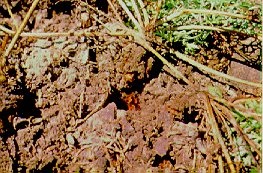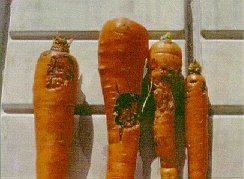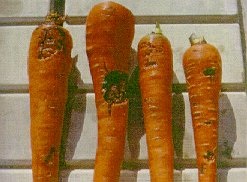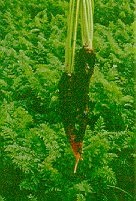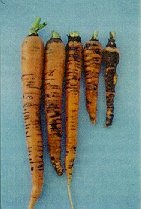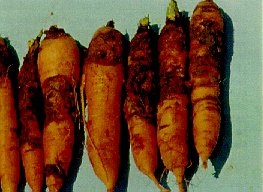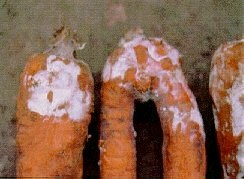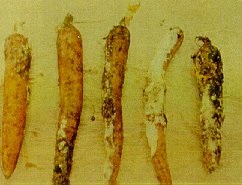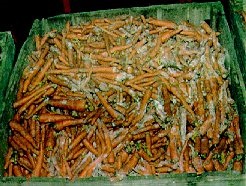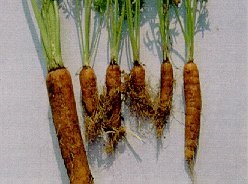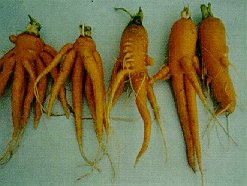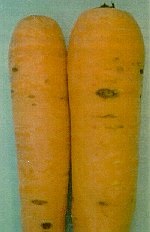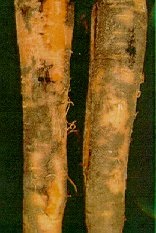Identification and management of carrot root diseases
Learn management strategies and how to identify carrot root diseases.
ISSN 1198-712X, Published January 1998
Introduction
Fresh market and processing carrots are grown across southern Ontario under a wide range of climatic and soil conditions ranging from light sandy soils to clay loams and highly organic muck soils. The marketable portion of the crop, the carrot root, is subjected to a wide range of field stresses which include diseases, nematodes and variations in soil conditions, notably moisture. The diseases of carrot roots are not limited to one soil type or another, however, we do see certain diseases more often on muck soils and certain others more often on highland or mineral soils. Accurate disease diagnosis is an important part of an Integrated Crop Management (ICM) program, both in the field and in storage. It is important that such diseases be recognized early in their development so that effective management strategies, if they exist, can be implemented. Careful and regular monitoring of the crop and a knowledge of the field history can provide valuable clues to the potential for disease. Seasonal weather patterns also have a major impact on carrot root diseases. A soil test for pH, salinity and nutrient levels is also a valuable tool.
Diseases such as crown rot, violet root rot, Sclerotinia white mold, cavity spot, Pythium root dieback and aster yellows are the most common diseases in Ontario. Crater rot, black root rot (black mold), black rot, scab and bacterial soft rot have not been commonly observed in Ontario. Crown rot and violet root rot are more common on mineral soils in southern Ontario, however, they are also found in muck soils. Nematodes and forked/split carrots are also common problems, however, nematodes are worm-like parasites, not disease organisms. Forked and split carrots can be caused by several different problems including nematodes, disease organisms and inconsistent soil conditions. Diagnosis is usually a process of elimination and assessment of detailed monitoring information.
Rhizoctonia
Rhizoctonia fungi are responsible for three important carrot root diseases. Two of these are common in Ontario: crown rot and violet root rot. Crater rot caused by Rhizoctonia carotae is rare in Ontario and tends to be more of a storage disease. Most of the diseases that affect carrot roots are soil-borne diseases which are greatly influenced by soil temperature, soil moisture, nutrition levels and sometimes variety with the exception of aster yellows. Aster yellows is a mycoplasma-like organism transmitted to carrots by the aster leafhopper. This insect-disease complex is covered in detail in two other OMAFRA fact sheets, Aster leafhopper and aster yellows and Carrot insects.
Crown rot
Crown rot is caused by the same Rhizoctonia fungus which causes damping-off when seedlings are small. On carrot roots, early symptoms are horizontal dark brown lesions; as the crop matures the tops may die in patches in the field (Figure 1). It is believed that infections can occur early in the growing season during wet periods, however, symptoms may not be detected until later in the season. Near harvest the lesions join to form large, deep, rotten areas on the top part of the root (Figure 2 and Figure 3). Control of this disease is nearly impossible if late summer and fall conditions are wet. Earlier harvests, planting on ridges, crop rotation, careful handling during harvest, storage sanitation and extremely good storage conditions might reduce losses to the disease. Reducing the spread of infected soil on cultivation and harvesting equipment is also important.
Violet root rot
Violet root rot is caused by a closely related species of Rhizoctonia, however, this disease has characteristically unique symptoms. It is found in patches in the field, often as weak areas or areas where the carrot tops are dying. Characteristic root symptoms are soil clinging to partially rotten, leathery textured roots. The leathery root surface will be a purplish or violet colour (Figure 4, Figure 5 and Figure 6). The only management suggestions are to avoid infected areas, rotate grain crops, ensure good drainage and nutrition and, most importantly, reduce the spread of infected soil on farm implements. Crater rot also caused by another species of Rhizoctonia is rare in Ontario. It is typically a dry rot and tends to show up in storage (Figure 7).
Crater rot
Sclerotinia white mold
Sclerotinia white mold is a very common disease of many vegetables and carrots are particularly susceptible, especially late in the season and during storage. The disease is present in soil, storage boxes or storage areas and often shows up after the crop has been harvested. Symptoms can be identified in the field; characteristic white mold with black sclerotia can been seen on the crown of infected carrots. In storage, the disease is characterized by a soft, watery rot with white mold and black sclerotia present (Figure 8 and Figure 9). Crop rotation, weed control (to improve air circulation), planting on raised beds, winter flooding, rapid cooling prior to storage and meticulous sanitation of all storage components are all necessary to reduce losses from white mold. Field applied fungicides are available, however, heavy disease pressure in the field or placement of carrots into infected storages will still lead to severe losses.
Cavity spot and Pythium root dieback
Several species of Pythium fungi cause characteristic diseases on carrots. Cavity spot and Pythium root dieback (formerly known as rusty root) are common diseases of carrots especially on muck soils. Infections from Pythium can occur early in the carrot's development and are generally favoured by moist soil conditions. Root dieback symptoms appear as rusty-brown lateral root formation, forking and stunting (Figure 10 and Figure 11). These symptoms can be easily confused with damage from nematodes, soil compaction or soil drainage problems. Cavity spot often shows up near harvest. Horizontal lesions varying in size from 1 to 10 mm appear on the surface of the root and can form into larger decayed areas if invaded by other fungi or bacteria (Figure 12). Cavity spot does not tend to reduce yield, however, it does affect the appearance and the marketability of the carrot. Management of Pythium diseases is difficult if the growing season is wet, however, some tolerant varieties are available. Also, precision planting on raised beds, crop rotations to cole crops, onions or potato and improvements to field drainage may help. There is evidence that high nitrogen levels in the soil may also contribute to the problem. Avoiding problem fields is helpful if that option is available. Soil applied fungicides or seed treatments for management of cavity spot may be helpful, however, if soil moisture conditions and disease pressure levels are good for the disease, problems may still occur.
Black Root Rot (Black Mold)
Black root rot (black mold) of carrots caused by the fungus Chalara elegans is very rare in Ontario. It is a post-harvest disease associated with carrots stored at high temperatures and humidity. The symptoms typically develop after the carrots have been washed and packaged in plastic and not stored at proper temperatures. Field symptoms are not seen. When temperatures are above 25 °C, dark, irregular lesions will develop on the surface of the root (Figure 13). Carrots damaged during packaging are more likely to become infected. Careful harvest handling and storage at proper temperatures from harvest to sale are the key management suggestions.
Black rot
Black rot of carrots caused by Alternaria fungi is different from black root rot mentioned previously and is also very rare in Ontario. This disease can be seed and soil-borne and is characterized by a shiny black decay at the crown area and a greenish-black mold on the taproot. Be sure to purchase clean and treated seed and follow the management guidelines recommended for Pythium diseases. In addition, an eight year rotation away from carrots, parsnips, parsley and celery and deep plowing of crop residues are recommended in infested fields.
Scab
Scab disease of carrots caused by the soil bacterium Streptomyces is also unusual in Ontario. Both raised and sunken, dry, corky lesions may form on the carrot root, however, symptoms are rarely severe enough to cause major yield losses. Alkaline soils are known to favour the incidence of scab.
Bacterial soft rots
Bacterial soft rots of carrots occur only when soil conditions are wet or storage conditions are poor. In very poorly drained areas or very wet fall seasons, bacterial tip rot can occur in the field. Such soft rots are characterized by a watery, smelly decay. Losses due to soft rot bacteria in storage usually appear after other storage diseases have taken hold. Careful harvest handling, grading and sanitation are the only ways to reduce the problem. Planting on raised beds in poorly drained areas may also reduce bacterial infections.
It is important to recognize and distinguish these root diseases of carrots from other problems. Nematodes such as root knot, root lesion and cyst cause some unique symptoms, which can be easily confused with diseases. Forked and split carrots are a major problem in many areas. These losses are often associated with inconsistent moisture patterns, soil compaction or disturbance patterns and sometimes, herbicide residues. It is important to properly diagnose carrot root diseases before initiating a management strategy.
References
- Diseases and Pests of Vegetable Crops in Canada
- IPM for onions, carrots, celery and lettuce in Ontario, OMAFRA Order No. 700
